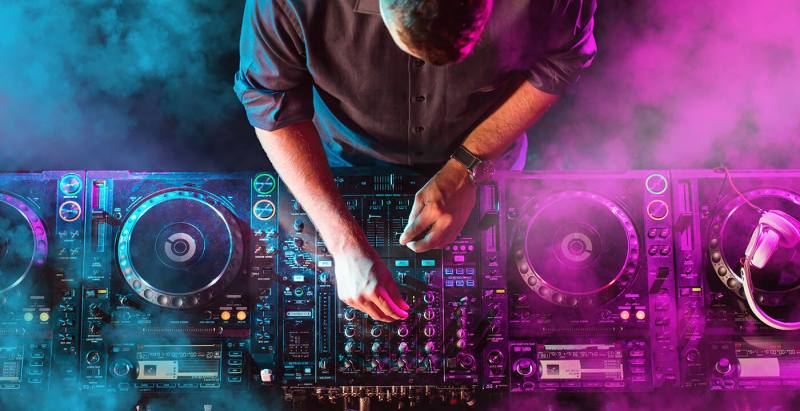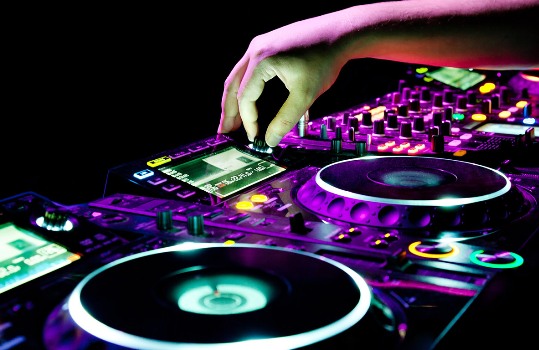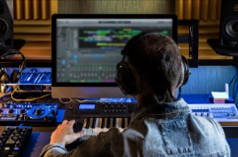
Think about the following questions.
1. What electronic music artists are you familiar with?
2. Do you agree with the idea that anyone can make music these days?
3. Do you like crowds, loud music, and dancing? Why or why not?
VOCABULARY PREVIEW
Match each New Academic Word List(NAWL) word with the correct definition.
- synthesis
- stadium _____
- variant _____
- uplifting _____
- integral _____
- manipulate _____
- a. very important and necessary
- b. a large structure for sports games and other events and their spectators
- c. causing happy and hopeful feelings
- d. the production of sounds or speech by using electronic equipment
- e. a different but related version of something
- f. to handle or control something, usually in a skillful manner
THE ELECTRONIC REVOLUTION

In the sense of using electronics to make music, "electronic music" has been around since the beginning of the 20th century. But what we think of today as electronic music-a wide genre that loosely fits under the umbrella of electronic dance music, or EDM—originated in the underground urban nightclubs of the late 1970s and early 1980s. Although its popularity has waxed and waned1 from the start, electronic music is currently as strong as ever.
Although they defy2 strict categorization, most variants of EDM share some basic characteristics. The first is the integral role of electronic sound synthesis. This began with analog electronic synthesizers and moved into digital synthesizer composition during the digital revolution. This genre strongly emphasizes repetitive3 dance rhythms that are heavy on drums and bass. Most EDM has a simple, 4/4 rhythm because it is uplifting and easy to dance to. Repeat the words "boots and pants, and boots and pants" over and over again aloud. That's the classic EDM beat. Vocals tend to be downplayed4, if they are even present at all. As DJs are central, and often also the original artists, the music favors electronic effects like cross-fades (smooth transitions from one sound to another) and digital sampling.
Electronic music had three distinct focal points of development. In Chicago, it was "house" music, named for the house parties where it was played in the early 1980s. Like its hip-hop cousin, house was born in black urban neighborhoods. "Techno" took hold in Detroit around the same time. Both used the "four on the floor" beat-a rhythm in 4/4 time in which the bass drum is played on every beat. But house had melodic5 roots in soul, funk, and disco, whereas techno was more minimal and synthetic-sounding. It often featured nothing more than a drum machine and robot-like bleeps and buzzes. In this regard, Detroit techno formed a bridge to Berlin, where European bands like Kraftwerk were defining the European electronic sound. In fact, the music scenes of Berlin, Detroit, and Chicago all influenced one another.
In the 1990s, diverse underground electronic movements converged6 under the term "electronica." This coincided7 with the beginnings of the "rave" scene. Raves began as informal and usually illegal gatherings that charged admission and changed venues8 every time. The unauthorized use of empty warehouses9 and other urban spaces along with spontaneous, word-of-mouth events contributed to the music's appeal. British musicians dominated raves on both sides of the Atlantic. Artists like the Chemical Brothers, the Prodigy, and Fatboy Slim began their careers at raves. They later enjoyed mainstream success beyond the club scene, selling out concerts in stadiums.
A third electronic wave hit in the early 2000s. Artists like Skrillex, Deadmau5, Diplo, and David Guetta appealed to the open-source philosophy of the era. The lines between producing music and DJing grew blurred10. DJs became more than just kids with cool record collections. They demanded recognition of the skills they exhibited in making remixes and manipulating tracks during live performances. And they got it. Artists like Skrillex took things one step further by encouraging and giving exposure to remixes by fans. This was a turning point. No longer passive consumers, the audience was now involved in the creative process, too.
Like any musical genre, EDM has had its share of criticism. Some fans of the music's underground roots question its current authenticity11, complaining that it has become too mainstream. It's true that some of the biggest EDM artists of the 2010s and 2020s, such as the Chain Smokers and Calvin Harris, have made catchy hit tunes with pop artists like BTS and Rhianna. Another popular DJ, Alan Walker, has been known to use "ghost producers" -artists who help create music without getting credit. Does this mean that EDM has lost its way creatively and is headed for a fall? Maybe. But this ever-evolving genre could just as easily rise again in a new electronic incarnation.
New Academic Word List
- wax and wane 1 : idiom. to become alternately larger and smaller
- defy 2 : v. to make difficult or impossible
- repetitive 3 : adj. repeating many times
- downplay 4 : v. to make less important
- melodic 5 : adj. of or relating to melody, a series of musical notes that form the main part of a song
- converge 6 : v. to come together
- coincide 7 : v. to happen at the same time
- venue 8 : n. the place where an event is held
- warehouse 9 : n. a large building used for storing goods
- blurred 10 : adj. not clear
- authenticity 11 : n. realness; genuineness
READING COMPREHENSION
A ‣ Mark each statement as true (T) or false (F) according to the reading.
- EDM was around before the introduction of digital synthesizers.
- True
- False
- In EDM, vocals provide the rhythm.
- True
- False
- The band Kraftwerk got its start in Chicago and Detroit clubs.
- True
- False
- Skrillex first became popular in the 2000s.
- True
- False
- Some critics of EDM say that it has lost what made it unique.
- True
- False
B ‣ Choose the best answer according to the reading.
- What is the reading mainly about?
- a. The definition and history of EDM
- b. The stars of today's EDM scene and why they are popular
- c. The difference between early techno music and today's digital EDM
- d. The early years of the musical movement that has become known as EDM
- Which of the following is NOT true of EDM?
- a. It usually uses a 4/4 beat.
- b. It has a number of variants.
- c. It emphasizes drums and bass.
- d. It is mainly popular in Europe.
- Which of the following is true about raves?
- a. They were usually held in stadiums.
- b. They were normally free to attend.
- c. They mostly featured American musicians.
- d. They are how several major artists got their start.
- The word incarnation in paragraph 6 is closest in meaning to _____.
- a. death
- b. form
- c. definition
- d. attempt
C ‣ The following terms are explained in the reading. Write definitions for them.
- four on the floor:
_____ - raves:
_____ - ghost producers:
_____
SUMMARY
Fill in the blanks with the phrases in the box.
- Chicago, Detroit, and Berlin
- cross-fades and samples
- roots and authenticity
- early 2000s
- rave scene
- dance beats
|
EDM
|
||
|
First Wave
|
Second Wave
|
Third Wave
|
|
Criticism
|
||
VOCABULARY PRACTICE
Fill in the blanks with the words in the box. Change the form if necessary.
- integral
- manipulate
- stadium
- synthesis
- uplifting
- variant
- The _____ was packed with a record number of baseball fans.
- Chimpanzees can _____ sticks and blades of grass in ways that resemble human tool use.
- Indoor soccer is a(n) _____ of the sport that typically involves faster, higher-scoring games.
- People who have lost the ability to speak can communicate using speech _____ technology.
- I wanted to cheer up my depressed friend but couldn't think of any _____ words.
- Henry Ford was _____ to the development of the modern mass-production process.
SUPPLEMENTAL READING
Ghost Producers

Within the music industry, the term "producer" has several different definitions. It can mean an executive. It can mean a type of musical director. And, increasingly, it can be synonymous with "recording artist." This last designation is now the norm within EDM.
Historically, music producers were more like film directors. They collaborated with performing artists on the arrangement of songs and musical themes within particular albums. They then coordinated the performing artists and studio technicians to create the product the team envisioned.
Developments in digital recording have streamlined this process. Now anyone can use software to make, mix, and record music in their own home. It is not even necessary to be able to sing or play an instrument. This has given rise to the electronic music producer—not only a one-person band, but a one-person recording team.
That image is personified by superstars like David Guetta and Skrillex. But there is some question as to how much of the writing and arranging big-name stars actually do themselves. "Ghost producers" are talented people who assist major stars without becoming famous themselves. They are in the business of providing everything from bass lines or drumbeats to fully finished products. In most cases, they are legally bound by contract not to name their employers.
In fact, artists have been working in this way since the invention of recording. In the end, one might ask why it matters—as long as the music sounds good.
Fill in the blanks with information from the reading.
- Music producers have traditionally been like musical versions of _____ .
- Developments in _____ have enabled individuals to take on all of the aspects of making music.
- Ghost producers may sign a(n) _____ agreeing not to name their employer.






















Leave a comment
Load more